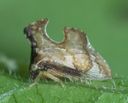Polyglyptini
Polyglyptini
Classification
- Phylum: Arthropoda
- Subphylum: Hexapoda
- Class: Insecta
- Order: Hemiptera
- Suborder: Auchenorrhyncha
- Infraorder: Cicadomorpha
- Superfamily: Membracoidea
- Family: Membracidae
- Subfamily: Smiliinae
- Tribe: Polyglyptini
Pronunciation
How to pronounce Polyglyptini: //ˌpɒlɪˈɡlɪptɪnaɪ//
These audio files are automatically generated. While they are not always 100% accurate, they are a good starting point.
Images






Summary
Polyglyptini is a diverse tribe of treehoppers within the Membracidae family, primarily recognized for their unique morphology and significant presence in New World ecosystems.
Physical Characteristics
Polyglyptini species have various physical characteristics that make them distinguishable from other treehoppers, often characterized by their unique body shapes and structures adapted for their arboreal environment.
Identification Tips
Look for their distinctive helmets or dorsal characteristics which often resemble plant structures, providing camouflage against predators.
Habitat
These insects typically inhabit wooded areas and can often be found on the stems of plants and trees.
Distribution
This tribe is primarily found in the New World, including various regions across North America and South America.
Diet
Polyglyptini feed on plant sap, utilizing their specialized mouthparts to extract nutrients from host plants.
Life Cycle
The life cycle of Polyglyptini includes an egg stage, a series of nymph stages, and an adult stage, resembling the typical hemipteran development with gradual metamorphosis.
Reproduction
Mating practices vary, but generally involve the male attracting a female through pheromones or physical displays; egg-laying typically occurs on host plants.
Predators
Common predators of Polyglyptini can include birds, spiders, and other insects that prey on smaller arthropods.
Ecosystem Role
Polyglyptini play a role in their ecosystems as herbivores, influencing plant health and serving as prey for various predators.
Collecting Methods
- Net sweeping
- Hand collecting
- Trapping
Preservation Methods
- Ethanol preservation
- Drying specimens
- Pinning for insect display
Evolution
The tribe Polyglyptini evolved alongside their host plants, demonstrating a strong co-evolutionary relationship that has influenced their morphological diversity.
Similar Taxa
Misconceptions
Some may confuse Polyglyptini with other similar-looking insects or assume they are harmful due to their plant-feeding habits, when they are generally not harmful to humans or pets.
Tags
- Polyglyptini
- treehoppers
- Hemiptera
- insecta
- ecosystem